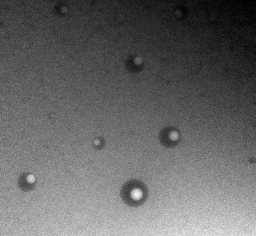UCLA scientists have succeeded in producing unique nanodroplets smaller than a human cell that could help deliver drugs

UCLA scientists have succeeded in producing unique nanodroplets smaller than a human cell that could help deliver drugs. "What we found and which was most surprising was the fact that inside each drop of oil there was also a drop of water, so we actually got a double emulsion," said Timothy Deming, a professor who serves as the head of the bioengineering department at the university.
The serious challenge," says Deming, "was to produce these compounds on a scale smaller than a hundred nanometers and obtain the desired properties in a steady state. We have demonstrated that it is indeed possible to obtain these emulsions so that they are stable in the range of these sizes, a result that no other researcher has been able to obtain to date. It is usually difficult to produce such double nanoemulsions and they are often unstable, but ours maintained high stability." Emulsions are drops of one type of liquid in another type of liquid - the two liquids do not mix with each other.
"The research gives us a new tool, a modern material that can be used in the delivery of drugs and in the fight against cancer, among other things." The research team created nanoemulsions containing about a billion double nanodroplets. Their research, which reports for the first time on obtaining droplets as small as XNUMX nanometers - the smallest double emulsions in the world - appears in the September issue of the journal Nature.
"If we have water-soluble drugs, we can load them into the droplets," says the researcher. If we have drugs that are not water-soluble, we can also charge them. We will be able to deliver both types of medication at the same time." "In this case, you effectively combine two types of medicinal compounds in the same carrier," says the researcher. "This approach could help in combined healing where you are interested in simultaneously delivering two types of drugs in a fixed ratio to the same defined location."
It may be possible to inject a drug into the droplet and inject the droplet itself into the interior of a biological cell, say the scientists. Will these droplets then be able to release their precious cargo inside the cell? "We are working on it," says the researcher who designed and prepared the compounds. "There is a relatively clear way of doing this. Admittedly, there are still challenges for effective drug transfer, but we were able to demonstrate the initial key step - it is possible to produce stable double emulsions of these sizes."
The "cargo" can be a protein toxin that helps destroy the cell. For example, one approach could contain an anti-cancer drug in the oil droplet and a toxic protein in the water droplet - two different compounds used to kill a cancer cell at the same time. While the cell is capable of developing resistance against a single drug, the combined approach may be more effective. The researchers are cautious with this approach and explain that although it contains the possibility of fighting cancer, there are still many stages left on the way, and probably many years of research, before it will be possible to treat patients using this approach. Clinical trials with this method will begin only in a few years.
"Although we will have to make many adjustments, this approach may have many advantages," says the lead researcher. "The size of the tiny drops is a significant advantage. We discovered a unique molecular property capable of stabilizing a double emulsion. These results are indeed promising, but it is too early and there is a lot of room for failures along the way. But, we must, at least, learn how to prepare more effective means of delivering drugs." In the next stages of the research, the scientists are interested in finding out if the droplets are able to penetrate the cells safely and release their cargo there. These nano-drops can also be used in the fields of cosmetics, soaps and shampoos.
The research laboratory tries to imitate a number of key characteristics that distinguish the natural proteins and integrate them into synthetic materials. The researcher Deming was present at Mason's lecture at the university where he explained how he was able to coat oil nanodroplets in water droplets using natural proteins; The two researchers agreed to combine the unique advantages inherent in the materials they developed, and this is how the aforementioned joint research was born.
Emulsions are the way to take oil, or oily substances that do not mix with water, and put them in a water-loving environment, where, being dispersed as droplets, they behave as a liquid. Emulsions have complex properties and are present in many and varied products including food products, plastics, cosmetics, oils and paints. "In the developing field of nanoemulsions, this research is a serious step forward," says the researcher.
Mason, being an undergraduate student at Princeton University in the early XNUMXs, developed a new field of research called thermal microrheology that is used today by scientists around the world. This field makes it possible to examine the viscosity and elasticity of soft materials, including liquids and emulsions, at the microscopic level.

One response
sounds interesting.
It looks like it could also have military uses…